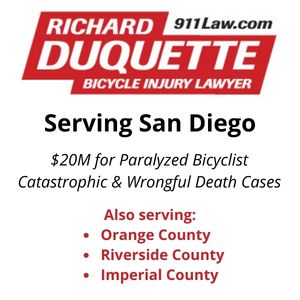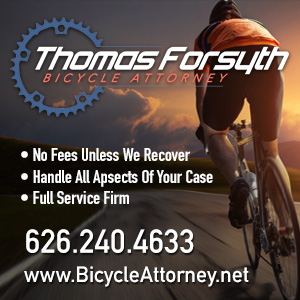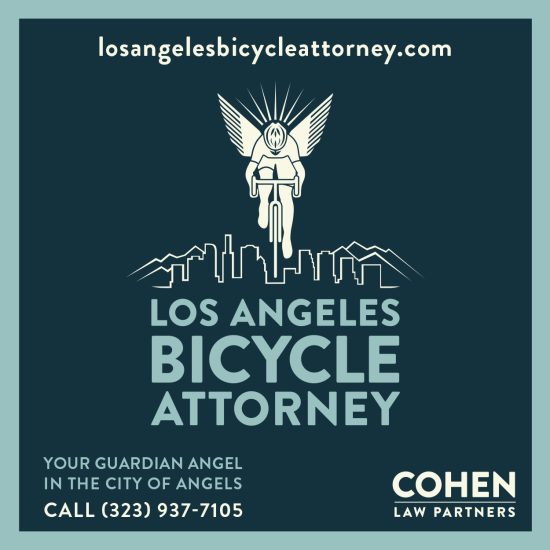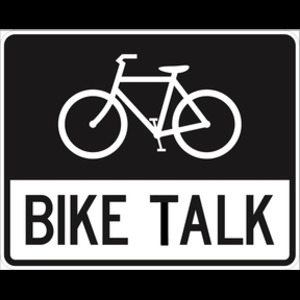A few quick — or maybe not so quick — updates on the ever-changing Susanna Schick/Pinkyracer case before we move on to other matters.
Schick’s friend Jennifer Beatty offers an update on her condition, along with the off-and-ongoing investigation on her ChipIn page, which is now up to nearly over $6000; seriously, you guys rock.
KPCC’s always excellent Patt Morrison interviews LAPD Chief Beck, asks him about the case and gets exactly the sort of non-specific answer you’d expect. But hats off to Patt for asking the question.
Meanwhile, KCRW’s Warren Olney discusses hit-and-run and the Pinkyracer case with Don Ward, aka Roadblock, and LAPD bike liaison Sgt. David Krumer; thanks to Mike for the heads-up.
Mike also sends word that police say Susanna Schick told them she was travelling at 18 mph before she fell; fast enough to get hurt, but hardly enough to account for her extensive injuries. Schick, who is now communicating online, confirmed on Twitter that her bike computer showed she was travelling at 18 mph just before the fall.
Or at least, that’s what they said to MSNBC.
The police officers who claimed to be following her — and who assisted her after they say she fell on her own with no provocation — insist she was riding at 30 miles per hour, according to KNBC-4.
That’s quite a speed differential.
Yes, a fall at 30 mph could very well result in the injuries she suffered. Only problem is, a top pro cyclist would have a hard time accelerating from a full stop to 30 mph on level ground in a few hundred feet. And no one has suggested that Schick was engaged in a mad sprint away from the light.
The mere fact that police investigators would believe she fell at 18 mph and suffered such severe injuries — or that she miraculously managed to hit 30 mph in such a short distance — demonstrates just how desperately traffic investigators need specialized training in bike collisions.
The MSNBC story that Mike referred to also says Schick was riding without lights and reflectors, which could help explain why the driver cut into the bike lane while she was in it. However, Schick has said she was at least using a rear blinkie, which the police should have seen.
And which seems to be visible — to people with better eyesight than I have these days, at least — in security footage posted online Thursday by the L.A. Times.
The pair of videos show a car exiting a parking garage on the 200 block of South Spring Street shortly before midnight, then what looks to be the same car swinging into the bike lane on Spring, barely missing a cyclist riding in the lane.
By barely, I mean it looks to be by inches, though camera angles can be deceiving.
Any cop who witnessed that and failed to stop the driver needs some serious retraining. Which doesn’t even come close to what I really want to say right now.
And after initially suggesting that Schick may have been drinking, LAPD Lt. Vernon now says there’s no evidence that alcohol played a roll in the incident.
It would be nice if he said that in the form of a public apology after so publicly smearing her.
He also says he examined the bike on Thursday, but didn’t see any sign of damage. But doesn’t mention who let him in, since the victim is in the hospital and her friend didn’t do it.
Then again, the police also said there was no damage to my bike after I was the victim of a road rage attack, even though I had to walk it two miles home because it wasn’t in ridable condition.
There’s that little matter of better police training in bike collision investigations again.
Meanwhile, LAist offers a great comment from Gary Kavanagh about the improbability of Susanna Schick suffering her injuries in a solo fall. As well as one from someone who witnessed the immediate aftermath of Schick’s fall, if not the fall itself or what caused it.
One more thing.
I’ve heard from a reliable source that police detectives have collected security camera footage from a building at 5th and Spring, which I’m told offers a clear view of the intersection in question.
So maybe, just maybe, we might actually find out what really happened last Friday night.
………
This weekend’s CicLAvia allows Angelenos to experience our city in a whole different way; and yes, it matters. Zev says it’s time to slow down, get off your bike and smell the CicLAvia. There will be a number of Westside feeder rides headed to the event, including rides from the Bikerowave and back again, too. LACBC offers tips for safe and happy riding this Sunday.
My advice?
Remember CicLAvia isn’t a Gran Fondo, it’s a moving street fest. And it belongs to every Angeleno and visitor willing to spend their Sunday without a motor, bike riders, pedestrians and skaters, older walkers in walkers and toddlers in tiaras. So slow down, enjoy the day and make room for everyone.
Seriously, don’t be a jerk. And have fun.
……..
The LACBC is in the process of forming a new Civics committee to offer a non-partisan look at local political candidates and help ensure the election of bike friendly politicians, to be co-chaired by board members Efren Moreno and myself.
We’re just looking for an open date for our first meeting, after our first two proposed dates failed to work out for various reasons. I’ll let you know as soon as we set a date and location, probably within a couple weeks.
The meeting, not the notification.
Meanwhile, a reader sends word suggesting that this may not be the city’s first non-partisan cycling organization.
In November, 1898, the East Side Cycling Club held its annual pre-election “smoker” party to which all the local political candidates were invited to speak before the wheelmen. The ESCC’s own platform basically had one plank (“Good Roads!”) and the club members themselves were of assorted political leanings.
So imagine the club’s surprise when the local Republicans mailed out post cards announcing that “there will be a Republican meeting at the hall of the bicycle club,” signed (oh so ironically) “Yours respectfully” by the Republican campaign secretary.
Think of the social media uproar this would have caused if only they’d had the technology back then! But instead, the club made do with chalk and fury.
On the evening of the smoker, all attendees were greeted with a conspicuous chalkboard. On it, the offending postcard was affixed next to a brief and unequivocal statement signed by the club’s board of directors, including Republican Owen McAleer, who himself was just a few years away from being L.A.’s mayor. Though concise, the message conveyed the ESCC’s staunch nonpartisanship, and to the club’s further credit, neither Republicans nor non-bikers were turned away from the event.
……..
My friends Sarah Amelar and Jon Riddle have written a new guide to Los Angeles bicycling, offering routes, tips and other useful information for locals and tourists alike; find it soon at your favorite local bike shop.
………
The cyclist who killed a 71-year old pedestrian in San Francisco apparently lied about laying his bike down to avoid a collision, while a bike commuter says it’s time to grow up and start acting like we belong here; I couldn’t agree more. However, while a cyclist killing a pedestrian is national news, pedestrians are killed by cars on a daily basis with hardly a peep.
And no, I don’t mean the candy kind.
Then again, bike cops don’t always seem to follow the law, either.
………
That Cypress Park kid who wrote to his councilmember asking for bike lanes in front of his school may be a lot older before he gets them. LADOT makes improvements to a key intersection along the new Expo bikeway. New buffered bike lanes will soon make their bow on Winnetka Ave. Caltech busts a bike thief. A Long Beach crime scene technician raises funds to replace an 82-year old cyclist’s stolen bike. A singer from Long Beach is planning a bike-based concert tour of the West Coast.
Cyclelicious asks who are all these legal drivers we keep hearing about, in contrast to all us scofflaw cyclists. A San Diego cyclist reflects on last month’s death of bike rider David Ortiz; thanks to David Huntsman for the heads-up. Moorpark struggles to find room for cyclists at the city’s skate park. Levi Leipheimer says he had a premonition that he was going to be hit by a car just moments before it actually happened; a Santa Rosa writer says a three-foot passing law, like the one currently under discussion in California, could have made a difference for Levi. A Sequoia mountain biker avoids death by millimeters when he’s impaled on a tree branch that just missed his jugular vein and cranial nerves. A hit-and-run driver kills a Richmond cyclist. A father and daughter are remembered after being killed by a speeding and possibly texting teenage driver in Concord, so why does the press insist on calling it an accident?
Bad bike shop marketing and service could be contributing to the lack of women riders; Bikeyface probably wouldn’t argue with that. Lovely Bicycle concludes cities do need bike lawyers. Five things drivers need to understand about sharing the road with cyclists, and 10 things you don’t need for bike touring. The makers of my favorite beer are the new official beer sponsor for the USA Pro Cycling Challenge; I guess Coors isn’t Colorado’s favorite anymore. Chicago cyclists support speed cameras for motorists. A Massachusetts cyclist is killed after his bike fails, possibly due to a recalled Cervelo fork.
Canada prepares for fair-weather bike traffic jams. Toronto’s Deputy Mayor urges city residents not to vote for cyclists. British Columbia police accuse a cyclist of staging fake bike collisions for a quick financial payout; damn, why didn’t I think of that? Looks like London’s cycling mayor won’t get the support of the city’s cyclists. A UK driver admits to screaming abuse at a pair of cyclists and obstructing them with his car; nice to know it’s not just American drivers who do that. New Zealand bike shops are warned that if you’re going to have a Going Out of Business Sale, you actually have to, you know, go out of business. Australia’s Global Mail offers a very nice, in-depth look at cycling in the City of Angeles, including quotes from several people you might know.
Finally, a New York pedestrian asks what the f*** is wrong with the city’s spandex-clad cyclists, among other Gothamists. Dave Moulton asks when did society decide that we don’t want dangerous and deadly driving to be a crime?
And I don’t think I ever got a chance to mention this great Spanish language PSA, courtesy of the LACBC’s City of Lights, LADOT and REI.
Like this:
Like Loading...










